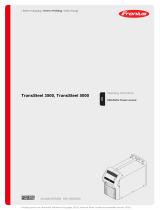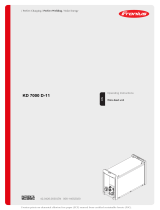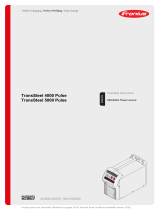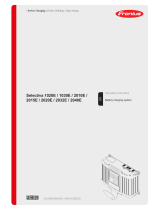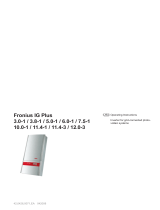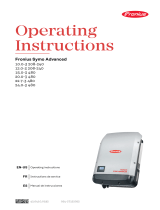Page is loading ...

Fronius prints on elemental chlorine free paper (ECF) sourced from certified sustainable forests (FSC).
/ Perfect Charging / Perfect Welding / Solar Energy
TransPocket 150
TransPocket 180
EN
Operating instructions
Rod electrode power source
42,0426,0203,EN 020-26082020


Contents
Safety rules 5
Explanation of safety notices 5
General 5
Proper use 5
Environmental conditions 6
Obligations of the operator 6
Obligations of personnel 6
Mains connection 6
Residual current protective device 7
Protecting yourself and others 7
Noise emission values 7
Danger from toxic gases and vapours 8
Danger from flying sparks 8
Risks from mains current and welding current 9
Meandering welding currents 10
EMC Device Classifications 10
EMC measures 10
EMF measures 11
Specific hazards 11
Requirement for the shielding gas 12
Danger from shielding gas cylinders 12
Safety measures at the installation location and during transport 13
Safety measures in normal operation 13
Commissioning, maintenance and repair 14
Safety inspection 14
Disposal 14
Safety symbols 15
Data protection 15
Copyright 15
General 16
Device concept 16
Warning notices on the device 17
Application areas 18
Before commissioning 19
Safety 19
Proper use 19
Setup regulations 19
Generator-powered operation 19
Controls, connections and mechanical components 21
Safety 21
TransPocket 150 controls, connections and mechanical components 22
TransPocket 180 controls, connections and mechanical components 23
Control panel 24
Preparatory work 25
MMA welding 26
MMA welding 26
SoftStart / HotStart function 26
Arc-force dynamic 27
Pulse welding 28
TIG welding 30
General 30
Connecting the gas cylinder 30
Preparatory work 30
Setting the gas pressure - on the welding torch with gas cut-off valve 32
TIG welding 32
TIG Comfort Stop 32
Pulse welding 34
Welding process Setup menu 36
Accessing the Setup menu 36
Changing welding parameters 36
3
EN

Exiting the Setup menu 36
Parameters for MMA welding 36
Parameters for TIG welding 37
Setup menu - Level 2 39
Welding parameters in the level 2 Setup menu 39
Care, maintenance and disposal 41
Safety 41
General 41
Maintenance at every start-up 41
Every 2 months 41
Disposal 42
Troubleshooting 43
Safety 43
Indicated errors 43
Service messages 43
No function 45
Faulty operation 46
Technical data 47
Explanation of the term "duty cycle" 47
TransPocket 150 47
TransPocket 180 48
TransPocket 180 MV 49
4

Safety rules
Explanation of
safety notices
DANGER!
Indicates immediate danger.
▶
If not avoided, death or serious injury will result.
WARNING!
Indicates a potentially hazardous situation.
▶
If not avoided, death or serious injury may result.
CAUTION!
Indicates a situation where damage or injury could occur.
▶
If not avoided, minor injury and/or damage to property may result.
NOTE!
Indicates a risk of flawed results and possible damage to the equipment.
General The device is manufactured using state-of-the-art technology and according to recog-
nised safety standards. If used incorrectly or misused, however, it can cause:
- injury or death to the operator or a third party,
- damage to the device and other material assets belonging to the operating com-
pany,
- inefficient operation of the device.
All persons involved in commissioning, operating, maintaining and servicing the device
must:
- be suitably qualified,
- have sufficient knowledge of welding and
- read and follow these operating instructions carefully.
The operating instructions must always be at hand wherever the device is being used. In
addition to the operating instructions, attention must also be paid to any generally applic-
able and local regulations regarding accident prevention and environmental protection.
All safety and danger notices on the device
- must be in a legible state,
- must not be damaged,
- must not be removed,
- must not be covered, pasted or painted over.
For the location of the safety and danger notices on the device, refer to the section
headed "General" in the operating instructions for the device.
Before switching on the device, rectify any faults that could compromise safety.
This is for your personal safety!
Proper use The device is to be used exclusively for its intended purpose.
5
EN

The device is intended solely for the welding processes specified on the rating plate.
Any use above and beyond this purpose is deemed improper. The manufacturer shall not
be held liable for any damage arising from such usage.
Proper use includes:
- carefully reading and following all the instructions given in the operating instructions
- studying and obeying all safety and danger notices carefully
- performing all stipulated inspection and maintenance work.
Never use the device for the following purposes:
- Thawing out pipes
- Charging batteries
- Starting engines
The device is designed for use in industry and the workshop. The manufacturer accepts
no responsibility for any damage caused through use in a domestic setting.
The manufacturer likewise accepts no liability for inadequate or incorrect results.
Environmental
conditions
Operation or storage of the device outside the stipulated area will be deemed as not in
accordance with the intended purpose. The manufacturer shall not be held liable for any
damage arising from such usage.
Ambient temperature range:
- during operation: -10 °C to + 40 °C (14 °F to 104 °F)
- during transport and storage: -20 °C to +55 °C (-4 °F to 131 °F)
Relative humidity:
- up to 50% at 40 °C (104 °F)
- up to 90% at 20 °C (68 °F)
The surrounding air must be free from dust, acids, corrosive gases or substances, etc.
Can be used at altitudes of up to 2000 m (6561 ft. 8.16 in.)
Obligations of the
operator
The operator must only allow persons to work with the device who:
- are familiar with the fundamental instructions regarding safety at work and accident
prevention and have been instructed in how to use the device
- have read and understood these operating instructions, especially the section
"safety rules", and have confirmed as much with their signatures
- are trained to produce the required results.
Checks must be carried out at regular intervals to ensure that operators are working in a
safety-conscious manner.
Obligations of
personnel
Before using the device, all persons instructed to do so undertake:
- to observe the basic instructions regarding safety at work and accident prevention
- to read these operating instructions, especially the "Safety rules" section and sign to
confirm that they have understood them and will follow them.
Before leaving the workplace, ensure that people or property cannot come to any harm
in your absence.
Mains connection Devices with a higher rating may affect the energy quality of the mains due to their cur-
rent consumption.
6

This may affect a number device types in terms of:
- Connection restrictions
-
Criteria with regard to the maximum permissible mains impedance
*)
-
Criteria with regard to the minimum short-circuit power requirement
*)
*)
at the interface with the public grid
see "Technical data"
In this case, the plant operator or the person using the device should check whether the
device may be connected, where appropriate by discussing the matter with the power
supply company.
IMPORTANT! Ensure that the mains connection is earthed properly
Residual current
protective device
Local regulations and national guidelines may require a residual current protective
device when connecting equipment to the public grid.
The type of residual current protective device recommended by the manufacturer for the
equipment is indicated in the technical data.
Protecting your-
self and others
Anyone working with the device exposes themselves to numerous risks, e.g.
- flying sparks and hot pieces of metal
- Arc radiation, which can damage eyes and skin
- Hazardous electromagnetic fields, which can endanger the lives of those using car-
diac pacemakers
- Risk of electrocution from mains current and welding current
- Greater noise pollution
- Harmful welding fumes and gases
Suitable protective clothing must be worn when working with the device. The protective
clothing must have the following properties:
- Flame-resistant
- Insulating and dry
- Covers the whole body, is undamaged and in good condition
- Safety helmet
- Trousers with no turn-ups
Protective clothing refers to a variety of different items. Operators should:
- Protect eyes and face from UV rays, heat and sparks using a protective visor and
regulation filter
- Wear regulation protective goggles with side protection behind the protective visor
- Wear stout footwear that provides insulation even in wet conditions
- Protect the hands with suitable gloves (electrically insulated and providing protection
against heat)
- Wear ear protection to reduce the harmful effects of noise and to prevent injury
Keep all persons, especially children, out of the working area while any devices are in
operation or welding is in progress. If, however, there are people in the vicinity:
- Make them aware of all the dangers (risk of dazzling by the arc, injury from flying
sparks, harmful welding fumes, noise, possible risks from mains current and welding
current, etc.)
- Provide suitable protective equipment
- Alternatively, erect suitable safety screens/curtains.
Noise emission
values
The device generates a maximum sound power level of <80 dB(A) (ref. 1pW) when idling
and in the cooling phase following operation at the maximum permissible operating point
under maximum rated load conditions according to EN 60974-1.
7
EN

It is not possible to provide a workplace-related emission value during welding (or cut-
ting) as this is influenced by both the process and the environment. All manner of differ-
ent welding parameters come into play, including the welding process (MIG/MAG, TIG
welding), the type of power selected (DC or AC), the power range, the type of weld
metal, the resonance characteristics of the workpiece, the workplace environment, etc.
Danger from
toxic gases and
vapours
The fumes produced during welding contain harmful gases and vapours.
Welding fumes contain substances that cause cancer, as stated in Monograph 118 of the
International Agency for Research on Cancer.
Use at-source extraction and a room extraction system.
If necessary, use a welding torch with an integrated extraction device.
Keep your face away from welding fumes and gases.
Fumes and hazardous gases
- must not be breathed in
- must be extracted from the working area using appropriate methods.
Ensure an adequate supply of fresh air. Ensure that there is a ventilation rate of at least
20 m³ per hour at all times.
Otherwise, a welding helmet with an air supply must be worn.
If there is any doubt about whether the extraction capacity is sufficient, the measured
toxic emission values should be compared with the permissible limit values.
The following components are responsible, amongst other things, for the degree of tox-
icity of welding fumes:
- Metals used for the workpiece
- Electrodes
- Coatings
- Cleaners, degreasers, etc.
- Welding process used
The relevant material safety data sheets and manufacturer's specifications for the listed
components should therefore be studied carefully.
Recommendations for trade fair scenarios, risk management measures and for identify-
ing working conditions can be found on the European Welding Association website under
Health & Safety (https://european-welding.org).
Flammable vapours (e.g. solvent fumes) should be kept away from the arc's radiation
area.
Close the shielding gas cylinder valve or main gas supply if no welding is taking place.
Danger from fly-
ing sparks
Flying sparks may cause fires or explosions.
Never weld close to flammable materials.
Flammable materials must be at least 11 metres (36 ft. 1.07 in.) away from the arc, or
alternatively covered with an approved cover.
A suitable, tested fire extinguisher must be available and ready for use.
Sparks and pieces of hot metal may also get into adjacent areas through small gaps or
openings. Take appropriate precautions to prevent any danger of injury or fire.
8

Welding must not be performed in areas that are subject to fire or explosion or near
sealed tanks, vessels or pipes unless these have been prepared in accordance with the
relevant national and international standards.
Do not carry out welding on containers that are being or have been used to store gases,
propellants, mineral oils or similar products. Residues pose an explosive hazard.
Risks from mains
current and weld-
ing current
An electric shock is potentially life threatening and can be fatal.
Do not touch live parts either inside or outside the device.
During MIG/MAG welding and TIG welding, the welding wire, the wirespool, the feed
rollers and all pieces of metal that are in contact with the welding wire are live.
Always set the wirefeeder up on a sufficiently insulated surface or use a suitable, insu-
lated wirefeeder holder.
Make sure that you and others are protected with an adequately insulated, dry base or
cover for the earth or ground potential. This base or cover must extend over the entire
area between the body and the earth or ground potential.
All cables and leads must be secured, undamaged, insulated and adequately dimen-
sioned. Replace loose connections and scorched, damaged, or inadequately dimen-
sioned cables and leads immediately.
Use the handle to ensure the power connections are tight before every use.
In the case of power cables with a bayonet connector, rotate the power cable around the
longitudinal axis by at least 180° and pretension.
Do not wrap cables or leads around the body or parts of the body.
The electrode (rod electrode, tungsten electrode, welding wire, etc.) must
- never be immersed in liquid for cooling
- Never touch the electrode when the power source is switched on.
Double the open circuit voltage of a power source can occur between the welding elec-
trodes of two power sources. Touching the potentials of both electrodes at the same time
may be fatal under certain circumstances.
Arrange for the mains cable to be checked regularly by a qualified electrician to ensure
the ground conductor is functioning properly.
Protection class I devices require a mains supply with ground conductor and a connector
system with ground conductor contact for proper operation.
Operation of the device on a mains supply without ground conductor and on a socket
without ground conductor contact is only permitted if all national regulations for protective
separation are observed.
Otherwise, this is considered gross negligence. The manufacturer shall not be held liable
for any damage arising from such usage.
If necessary, provide adequate earthing for the workpiece.
Switch off unused devices.
Wear a safety harness if working at height.
Before working on the device, switch it off and pull out the mains plug.
Attach a clearly legible and easy-to-understand warning sign to the device to prevent
anyone from plugging the mains plug back in and switching it on again.
After opening the device:
- Discharge all live components
- Ensure that all components in the device are de-energised.
9
EN

If work on live parts is required, appoint a second person to switch off the main switch at
the right moment.
Meandering weld-
ing currents
If the following instructions are ignored, meandering welding currents can develop with
the following consequences:
- Fire hazard
- Overheating of parts connected to the workpiece
- Irreparable damage to ground conductors
- Damage to device and other electrical equipment
Ensure that the workpiece is held securely by the workpiece clamp.
Attach the workpiece clamp as close as possible to the area that is to be welded.
Position the device with sufficient insulation against electrically conductive environments,
e.g. Insulation against conductive floor or insulation to conductive racks.
If distribution boards, twin-head mounts, etc., are being used, note the following: The
electrode of the welding torch / electrode holder that is not used is also live. Make sure
that the welding torch / electrode holder that is not used is kept sufficiently insulated.
In the case of automated MIG/MAG applications, ensure that only an insulated wire elec-
trode is routed from the welding wire drum, large wirefeeder spool or wirespool to the
wirefeeder.
EMC Device Clas-
sifications
Devices in emission class A:
- Are only designed for use in industrial settings
- Can cause line-bound and radiated interference in other areas
Devices in emission class B:
- Satisfy the emissions criteria for residential and industrial areas. This is also true for
residential areas in which the energy is supplied from the public low-voltage mains.
EMC device classification as per the rating plate or technical data.
EMC measures In certain cases, even though a device complies with the standard limit values for emis-
sions, it may affect the application area for which it was designed (e.g. when there is
sensitive equipment at the same location, or if the site where the device is installed is
close to either radio or television receivers).
If this is the case, then the operator is obliged to take appropriate action to rectify the
situation.
Check and evaluate the immunity to interference of nearby devices according to national
and international regulations. Examples of equipment that may be susceptible to interfer-
ence from the device include:
- Safety devices
- Power, signal and data transfer lines
- IT and telecommunications devices
- Measuring and calibrating devices
Supporting measures for avoidance of EMC problems:
1. Mains supply
- If electromagnetic interference arises despite correct mains connection, addi-
tional measures are necessary (e.g. use a suitable line filter).
10

2. Welding power leads
- must be kept as short as possible
- must run close together (to avoid EMF problems)
- must be kept well apart from other leads
3. Equipotential bonding
4. Earthing of the workpiece
- If necessary, establish an earth connection using suitable capacitors.
5. Shielding, if necessary
- Shield off other nearby devices
- Shield off entire welding installation
EMF measures Electromagnetic fields may pose as yet unknown risks to health:
- effects on the health of others in the vicinity, e.g. wearers of pacemakers and hear-
ing aids
- wearers of pacemakers must seek advice from their doctor before approaching the
device or any welding that is in progress
- for safety reasons, keep distances between the welding cables and the welder's
head/torso as large as possible
- do not carry welding cables and hosepacks over the shoulders or wind them around
any part of the body
Specific hazards Keep hands, hair, clothing and tools away from moving parts. For example:
- Fans
- Cogs
- Rollers
- Shafts
- Wirespools and welding wires
Do not reach into the rotating cogs of the wire drive or into rotating drive components.
Covers and side panels may only be opened/removed while maintenance or repair work
is being carried out.
During operation
- Ensure that all covers are closed and all side panels are fitted properly.
- Keep all covers and side panels closed.
The welding wire emerging from the welding torch poses a high risk of injury (piercing of
the hand, injuries to the face and eyes, etc.).
Therefore always keep the welding torch away from the body (devices with wire-feed
unit) and wear suitable protective goggles.
Never touch the workpiece during or after welding - risk of burns.
Slag can jump off cooling workpieces. The specified protective equipment must therefore
also be worn when reworking workpieces, and steps must be taken to ensure that other
people are also adequately protected.
Welding torches and other parts with a high operating temperature must be allowed to
cool down before handling.
Special provisions apply in areas at risk of fire or explosion - observe relevant
national and international regulations.
Power sources for work in areas with increased electric risk (e.g. near boilers) must carry
the "Safety" sign. However, the power source must not be located in such areas.
Risk of scalding from escaping coolant. Switch off cooling unit before disconnecting
coolant flow or return lines.
11
EN

Observe the information on the coolant safety data sheet when handling coolant. The
coolant safety data sheet may be obtained from your service centre or downloaded from
the manufacturer's website.
Use only suitable load-carrying equipment supplied by the manufacturer when transport-
ing devices by crane.
- Hook chains and/or ropes onto all suspension points provided on the load-carrying
equipment.
- Chains and ropes must be at the smallest angle possible to the vertical.
- Remove gas cylinder and wire-feed unit (MIG/MAG and TIG devices).
If the wire-feed unit is attached to a crane holder during welding, always use a suitable,
insulated wirefeeder hoisting attachment (MIG/MAG and TIG devices).
If the device has a carrying strap or handle, this is intended solely for carrying by hand.
The carrying strap is not to be used if transporting with a crane, counterbalanced lift truck
or other mechanical hoist.
All lifting accessories (straps, handles, chains, etc.) used in connection with the device or
its components must be tested regularly (e.g. for mechanical damage, corrosion or
changes caused by other environmental factors).
The testing interval and scope of testing must comply with applicable national standards
and directives as a minimum.
Odourless and colourless shielding gas may escape unnoticed if an adapter is used for
the shielding gas connection. Prior to assembly, seal the device-side thread of the
adapter for the shielding gas connection using suitable Teflon tape.
Requirement for
the shielding gas
Especially with ring lines, contaminated shielding gas can cause damage to equipment
and reduce welding quality.
Meet the following requirements regarding shielding gas quality:
- Solid particle size < 40 µm
- Pressure condensation point < -20 °C
- Max. oil content < 25 mg/m³
Use filters if necessary.
Danger from
shielding gas cyl-
inders
Shielding gas cylinders contain gas under pressure and can explode if damaged. As the
shielding gas cylinders are part of the welding equipment, they must be handled with the
greatest of care.
Protect shielding gas cylinders containing compressed gas from excessive heat, mech-
anical impact, slag, naked flames, sparks and arcs.
Mount the shielding gas cylinders vertically and secure according to instructions to pre-
vent them falling over.
Keep the shielding gas cylinders well away from any welding or other electrical circuits.
Never hang a welding torch on a shielding gas cylinder.
Never touch a shielding gas cylinder with an electrode.
Risk of explosion - never attempt to weld a pressurised shielding gas cylinder.
Only use shielding gas cylinders suitable for the application in hand, along with the cor-
rect and appropriate accessories (regulator, hoses and fittings). Only use shielding gas
cylinders and accessories that are in good condition.
Turn your face to one side when opening the valve of a shielding gas cylinder.
12

Close the shielding gas cylinder valve if no welding is taking place.
If the shielding gas cylinder is not connected, leave the valve cap in place on the cylin-
der.
The manufacturer's instructions must be observed as well as applicable national and
international regulations for shielding gas cylinders and accessories.
Safety measures
at the installation
location and dur-
ing transport
A device toppling over could easily kill someone. Place the device on a solid, level sur-
face such that it remains stable
- The maximum permissible tilt angle is 10°.
Special regulations apply in rooms at risk of fire or explosion
- Observe relevant national and international regulations.
Use internal directives and checks to ensure that the workplace environment is always
clean and clearly laid out.
Only set up and operate the device in accordance with the degree of protection shown
on the rating plate.
When setting up the device, ensure there is an all-round clearance of 0.5 m (1 ft. 7.69
in.) to ensure that cooling air can flow in and out freely.
When transporting the device, observe the relevant national and local guidelines and
accident prevention regulations. This applies especially to guidelines regarding the risks
arising during transport.
Do not lift or transport operational devices. Switch off devices before transport or lifting.
Before transporting the device, allow coolant to drain completely and detach the follow-
ing components:
- Wirefeeder
- Wirespool
- Shielding gas cylinder
After transporting the device, the device must be visually inspected for damage before
commissioning. Any damage must be repaired by trained service technicians before
commissioning the device.
Safety measures
in normal opera-
tion
Only operate the device when all safety devices are fully functional. If the safety devices
are not fully functional, there is a risk of
- injury or death to the operator or a third party
- damage to the device and other material assets belonging to the operator
- inefficient operation of the device
Any safety devices that are not functioning properly must be repaired before switching on
the device.
Never bypass or disable safety devices.
Before switching on the device, ensure that no one is likely to be endangered.
Check the device at least once a week for obvious damage and proper functioning of
safety devices.
Always fasten the shielding gas cylinder securely and remove it beforehand if the device
is to be transported by crane.
13
EN

Only the manufacturer's original coolant is suitable for use with our devices due to its
properties (electrical conductibility, anti-freeze agent, material compatibility, flammability,
etc.).
Only use suitable original coolant from the manufacturer.
Do not mix the manufacturer's original coolant with other coolants.
Only connect the manufacturer's system components to the cooling circuit.
The manufacturer accepts no liability for damage resulting from use of other system
components or a different coolant. In addition, all warranty claims will be forfeited.
Cooling Liquid FCL 10/20 does not ignite. The ethanol-based coolant can ignite under
certain conditions. Transport the coolant only in its original, sealed containers and keep
well away from any sources of ignition.
Used coolant must be disposed of properly in accordance with the relevant national and
international regulations. The coolant safety data sheet may be obtained from your ser-
vice centre or downloaded from the manufacturer's website.
Check the coolant level before starting to weld, while the system is still cool.
Commissioning,
maintenance and
repair
It is impossible to guarantee that bought-in parts are designed and manufactured to meet
the demands made of them, or that they satisfy safety requirements.
- Use only original spare and wearing parts (also applies to standard parts).
- Do not carry out any modifications, alterations, etc. to the device without the manu-
facturer's consent.
- Components that are not in perfect condition must be replaced immediately.
- When ordering, please give the exact designation and part number as shown in the
spare parts list, as well as the serial number of your device.
The housing screws provide the ground conductor connection for earthing the housing
parts.
Only use original housing screws in the correct number and tightened to the specified
torque.
Safety inspection The manufacturer recommends that a safety inspection of the device is performed at
least once every 12 months.
The manufacturer recommends that the power source be calibrated during the same 12-
month period.
A safety inspection should be carried out by a qualified electrician
- after any changes are made
- after any additional parts are installed, or after any conversions
- after repair, care and maintenance has been carried out
- at least every twelve months.
For safety inspections, follow the appropriate national and international standards and
directives.
Further details on safety inspection and calibration can be obtained from your service
centre. They will provide you on request with any documents you may require.
Disposal Do not dispose of this device with normal domestic waste! To comply with the European
Directive on Waste Electrical and Electronic Equipment and its implementation as
national law, electrical equipment that has reached the end of its life must be collected
14

separately and returned to an approved recycling facility. Any device that you no longer
require must either be returned to your dealer or given to one of the approved collection
and recycling facilities in your area. Ignoring this European Directive may have poten-
tially adverse affects on the environment and your health!
Safety symbols Devices with the CE mark satisfy the essential requirements of the low-voltage and elec-
tromagnetic compatibility directives (e.g. relevant product standards of the EN 60 974
series).
Fronius International GmbH hereby declares that the device is compliant with Directive
2014/53/EU. The full text on the EU Declaration of Conformity can be found at the follow-
ing address: http://www.fronius.com
Devices marked with the CSA test mark satisfy the requirements of the relevant stand-
ards for Canada and the USA.
Data protection The user is responsible for the safekeeping of any changes made to the factory settings.
The manufacturer accepts no liability for any deleted personal settings.
Copyright Copyright of these operating instructions remains with the manufacturer.
The text and illustrations are all technically correct at the time of printing. We reserve the
right to make changes. The contents of the operating instructions shall not provide the
basis for any claims whatsoever on the part of the purchaser. If you have any sugges-
tions for improvement, or can point out any mistakes that you have found in the instruc-
tions, we will be most grateful for your comments.
15
EN

General
Device concept
The power source has the following properties:
- Compact dimensions
- Robust plastic housing
- Extremely reliable even under harsh operating conditions
- Carrying strap for easy transport on construction sites, etc.
- Protected controls
- Current sockets with bayonet latch
In conjunction with the digital resonance inverter, an electronic regulator adapts the
power source characteristic to suit the welding electrode during welding. The result is a
lightweight and compact device with excellent ignition and weld properties.
The power source also features a Power Factor Correction, which adapts the current
consumption of the power source to the sinusoidal mains voltage. This results in numer-
ous advantages for the user, such as:
- Low primary current
- Low conduction losses
- Late tripping of the circuit breaker
- Improved stability in the event of voltage fluctuations
- Long mains leads can be used
- In the case of multivoltage devices, a continuous input voltage range
When using cellulose electrodes (CEL), a dedicated operating mode can be chosen for
perfect welding results.
16

Warning notices
on the device
The warning notices and safety symbols on the power source must not be removed or
painted over. They warn against incorrect operation which can lead to serious injury
and damage.
Meaning of safety symbols on the device:
Welding is dangerous. The following basic requirements must be met to
ensure the equipment is used properly:
- Welders must be sufficiently qualified
- Suitable protective equipment must be used
- All persons not involved must be kept at a safe distance from the welding
process
Do not use the functions described here until you have fully read and under-
stood the following documents:
- these operating instructions
- all the operating instructions for the system components of the power
source, especially the safety rules
Do not dispose of used devices with domestic waste. Dispose of them
according to the safety rules.
17
EN

Application areas
MMA welding
TIG welding, welding torch with gas cut-off valve
18

Before commissioning
Safety
WARNING!
Danger due to incorrect operation and incorrectly performed work.
This can result in serious injury and damage to property.
▶
All the work and functions described in this document must only be carried out by
trained and qualified personnel.
▶
Read and understand this document.
▶
Read and understand all the Operating Instructions for the system components,
especially the safety rules.
Proper use The power source is intended exclusively for MMA welding and TIG welding in conjunc-
tion with system components from Fronius.
Utilisation for any other purpose, or in any other manner, shall be deemed to be not in
accordance with the intended purpose.
The manufacturer shall not be held liable for any damages arising from such usage.
Proper use also includes:
- carefully reading these operating instructions
- following all the instructions and safety rules in these operating instructions
- performing all stipulated inspection and maintenance work
Setup regulations
WARNING!
Danger from machines falling or toppling over.
This can result in serious injury and damage to property.
▶
Place devices on a solid, level surface in such a way that they remain stable.
The device is tested to IP 23 protection, meaning:
- Protection against penetration by solid foreign bodies with diameters > 12.5 mm
(0.49 in.)
- Protected against spraywater at any angle up to 60° to the vertical
Cooling air
The device must be set up in such a way that cooling air can flow freely through the slots
in the front and rear panels.
Dust
Ensure that metallic dust is not sucked into the system by the fan, when carrying out
grinding for example.
Outdoor operation
The device can be set up and operated outdoors in accordance with IP23 degree of pro-
tection. Avoid direct wetting (e.g. from rain).
Generator-
powered opera-
tion
The power source is generator-compatible.
In order to dimension the required generator output, the maximum apparent power S
1max
of the power source is required.
19
EN

The maximum apparent power S
1max
of the power source can be calculated as follows:
S
1max
= I
1max
x U
1
See device rating plate or technical data for I
1max
and U
1
values
The generator apparent power S
GEN
needed is calculated using the following rule of
thumb:
S
GEN
= S
1max
x 1.35
A smaller generator may be used when not welding at full power.
IMPORTANT! The generator apparent power S
GEN
must always be higher than the max-
imum apparent power S
1max
of the power source.
When using single-phase devices with a 3-phase generator, note that the specified gen-
erator apparent power is often only available as a whole across all three phases of the
generator. If necessary, obtain further information on the single-phase power of the gen-
erator from the generator manufacturer.
NOTE!
The voltage delivered by the generator must never exceed the upper or lower lim-
its of the mains voltage tolerance range.
Details of the mains voltage tolerance can be found in the "Technical data" section.
20
/
